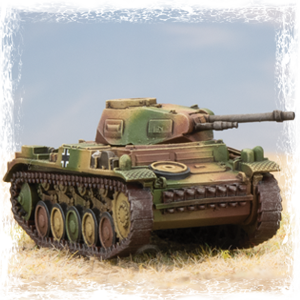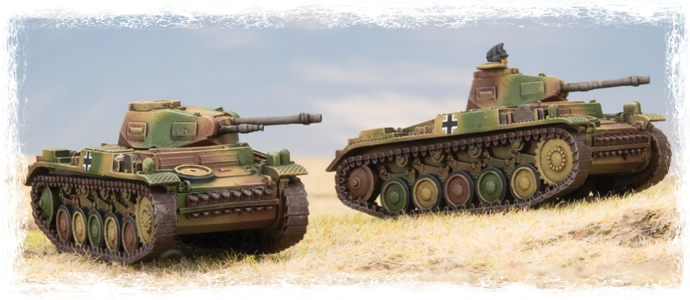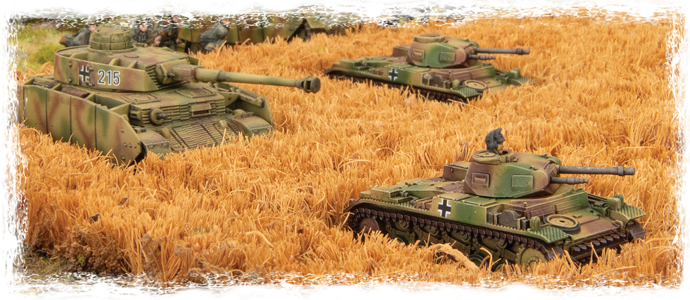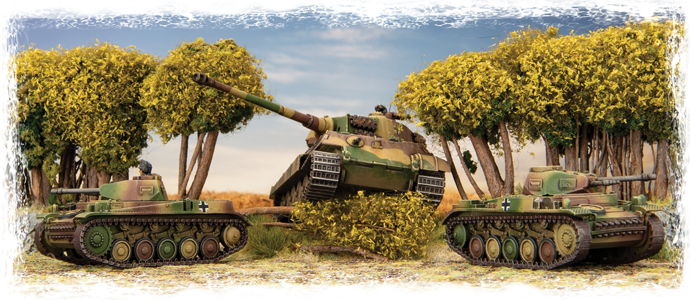|
|
From the Thirties, with love
 |
From the Thirties, with love
With Livio Tonazzo
With great surprise, an Early War tank appears among the new releases of Berlin: German: make way for the Panzer II! That's right, you got it right; together with the models of the Waffentrager and the Kleinepanzer Wanze which are makeshift means of the last phase of the war, Battlefront offers us an exciting plastic kit for the Panzer II, a tank prior to the outbreak of the Second World War.
From a modelling point of view it is certainly a new kit that was somewhat missed, but also from a game point of view there are interesting implications, testifying that even obsolete vehicles can find their own role in the game. I also hope - but here it is my personal hope as a huge Early War fan - the release of this kit is a sweet omen for the remake of what I consider to be Flames of War's most fascinating period.
|
|
The Panzer II is a tank developed starting in 1934 as a successor to the Panzer I. It is the first version of the Panzer equipped with a gun, since the predecessor was armed only with two machine guns. Entered service in 1936, it is not clear whether it was used from 88. Panzer-Abteilung in the Spanish War in support of the nationalist insurgents or instead, it had the baptism of fire only with the Second World War. The occupations of Austria and Czechoslovakia, which also saw Panzer II as protagonists, were completely unchallenged. During the Polish Campaign, however, the Panzer IIs played a leading role as they represented about half of all German tanks used (about 1,200 out of 2,690). The 1939 campaign was as short as it was intense, and as many as 259 vehicles were put out of action. Therefore, the shortcomings in terms of protection were immediately highlighted as the frontal armour of 30-35mm was often ineffective against anti-tank or even field guns. The additional 20mm plates that were installed on most Panzer IIs did not solve the problem if the German command during the French campaign relegated these tanks mostly to non-critical sectors. Of the approximately 950 Panzer II deployed in the French campaign, in fact, only 146 were used by the XIX Panzerkorps for the breakthrough of the Ardennes. The losses were at first contained due to the surprise effect but became more pronounced as the fighting became more intense (as during the British counter-attack near Arras).
|
|

|
| The comparison with the French tanks Somua S35 and Char-B1 however highlighted the predominant role of medium tanks compared to light tanks. Therefore, already from 1940-1941, there was a progressive relegation of the Panzer II to an armoured reconnaissance role. In subsequent theatres of war such as those of North Africa or Eastern Europe, the Panzer II continued to be present but in a role (that of reconnaissance) very different from the original one while the use as a real tank was sporadic and limited to infantry left isolated and without anti-tank support. Between 1942 and 1943 the Panzer IIs were progressively withdrawn from service, being relegated to tasks of training, maintenance of public order and anti-partisan struggle. The hull instead was reused for self-propelled artillery (Wespe) and tank destroyers (Marder). The last examples of Panzer II to be used on the battlefields were those belonging to the Training Schools, which were recalled to service in desperate attempts to slow down the unstoppable advance of the Red Army in 1945. |
| At the end of the war, no one could expect great things from a Panzer II, the profile in Berlin: German does not hide surprises compared to what we had already seen previously. |
 |
| The Panzer II has a Front Armor of 3, just enough to attempt to withstand hits from light anti-tank weapons from guns, armoured cars or light armour. Very often the anti-tank value of these weapons is equal to 7, this means that you need a roll of 4+ to equalize a hit, while with a roll of 1-3, you risk being destroyed. Of course, we are talking about the least effective weapons if we leave out the small arms and some 20mm anti-aircraft. Medium and heavy anti-tank weapons leave little hope of survival. The Side Armor is equal to 1, insufficient to guarantee total protection even from rifle and mg shots. It doesn't happen often for heaven's sake, but sometimes you can roll a 1 on Armor Save and your opponent can roll a 6 on Firepower. It is never pleasant for the attacker. On the other hand, in the Late War having an armour of 1 or 2 changes very little because the anti-tank weapons available to the infantry are many more so defensive fire is more effective. Only armour of 8 is effective in saving enemy blows and represents a guarantee or almost for the assault, even a side armour of 6 means little or nothing. The Top armour is equal to 1, as for all armoured vehicles. In the Late War it does not represent the guarantee it represents in the Mid (or Early) as infantry anti-tank weapons also hit the side in assault and not just defensive fire, however, it does offer some protection against those infantry units that have left the panzerfaust at home. |
| From the point of view of mobility, the Panzer II does not particularly shine without disappointment. The Tactical move is the standard one equal to 10", while the value of Cross Country Dash is equal to 16". The latter is also quite common as a value, many tanks with average performance have this value. A less happy point is the values of Terrain Dash and Road Dash. Usually, the former is expected to be somewhere between Tactical Move and Cross-country Dash and the latter to be much better than Cross-country Dash. The Panzer II, on the other hand, has a very modest Terrain Dash value of 12" which makes it particularly good for advancing on land. This can be a particularly important problem for a tank that has to exploit the terrain without being able to count on its own battleship. Very often not being seen is the best protection and to do so you will often have to exploit the terrain. |
 |
|
Furthermore, the Cross value is equal to 3+, in medio stat virtus (virtue lies in the middle). In this case, a very common value among the tanks of Flames of War gives some guarantees but does not let you sleep peacefully as some 1-2 could upset the plans. If I can give a tip use the Cross Here order when you can, you will give up shooting (and assault) but at least you will test with a value of 2+ which offers much more guarantees. Road Dash usually it is considered little because it is difficult for a road to be exactly where it should be and it can also enjoy some protection so as not to leave teams using this movement exposed. In many years only once have I seen a Road Dash used successfully, but yes it was a very long road that cuts diagonally into a third of the field and could count on several rows of trees. This too is not particularly brilliant and is equal to 18", just 2" higher than that of the Cross-Country dash. And what about the offensive capacity? Well, it is absolutely in line with that of a 1930s tank. The Panzer mounts a 20mm cannon that can make the enemy ring at 20”. The anti-tank value is that of such weapons, i.e. 5. It is an effective value only against armoured cars and lightly armoured vehicles, even against light tanks with Front Armor 3 it is almost ineffective. The ROF is not rewarding because the cannon is not that of the fast-loading Luchs, in fact, it has a Halted ROF of 2 and a Moving ROF of 1. The Firepower is not particularly rewarding either, with a value of 5+ there will be much more chances to bail than to destroy an enemy tank that has had its armour pierced.
|
| Where to find the Panzer II in the new book Berlin: German? The fearsome Panzer II can be taken within a Tank Training formation, which represents precisely the companies put up with the means of the tanker schools. Being crews in training it is not surprising that the training leaves much to be desired. The value of Is Hit On is equal to Aggressive 3+, so hitting the Panzer IIs won't be particularly difficult. On the other hand, what will be particularly complicated will be being able to place orders given the fi Green 5+ rating. When only one order out of three will be crowned with success, very often it is better to forget to use them. In these cases, one of the few orders that can be used lightly is Shoot & Scoot since it has no drawbacks as the Blitz does. Try not to be flattered by the Stormtroopers rule, it will be almost impossible to double order. Morale is overall fair and equal to Confident 4+, even if it suffers from the difficult situation of the last glimpses of the war as the Third Reich rule is missing which usually guaranteed a better Last Stand. |
 |
|
A Tank Training Formation is a very varied formation that can deploy all the tanks in the German fleet: Panther, Stug, Hetzer, Panzer IV ... and of course, the Panzer II which however is not in the compulsory slot and therefore must be in addition to other heavier tanks. The investment in terms of points will not be particularly important, in fact, I would say that it is reduced to a minimum (less than that is difficult). On the other hand, precisely for this reason, taking a Panzer II platoon is a really good idea if you choose a Tank Training Formation. For a truly negligible cost, in fact, it will be possible to deploy a platoon of 3 tanks that counts for the Morale of the Formation: this means that the formation will be more difficult to put to flight. I recall that a formation is destroyed when it doesn't have two units still operational. While it's not something I like to do, just keeping this platoon in the rear, maybe in a wood, can be to avoid a break. But deploying a unit to keep it hidden I find it a bit boring; I prefer to give it a role on the battlefield. But what could a 1930s tank do in 1945? From my point of view, its role is to hunt down enemy armored cars. Thanks to 3's Front Armor it should be able to withstand some damage and force the opposing platoons to Last Stand. Usually, the recon units tend to run away easily and for this reason, bailing the teams that compose it can be enough. Against these units the Panzer II puts its main features to good use, i.e. the aforementioned front armour, a gun capable of piercing almost exclusively armour equal to 1 and a disappointing Firepower that will hardly destroy the opposing teams.
|
|
Another reason to deploy the Panzer II? The beautiful new plastic kit!!!!
~ Livio Tonazzo
|
|
|